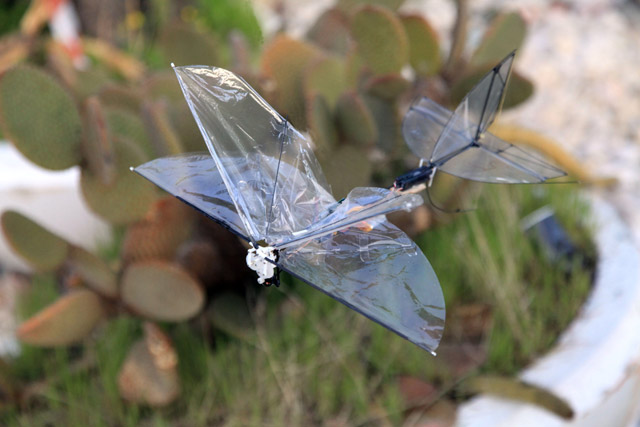When the Israel Aerospace Industries (IAI) "butterfly" unmanned air vehicle, or rather super micro vehicle, takes off in one of the company's hangars, it looks like a toy for spoiled boys who have parents with really deep pockets. In reality, it is being developed for far more serious scenarios.
The "butterfly" is practically silent and, when it hovers a few metres above your head, sometimes merges with the background and seems to disappear. This is exactly what IAI wants to achieve - a miniature UAV that can enter buildings and relay video and sound to forces outside.
Six years ago, an engineer involved in some of IAI's major projects decided to study the motion of butterfly wings to create a fluttering robot suitable for military missions. The idea came as no surprise for many at IAI as the engineer in question is also chairman of the Israeli Lepidopterists Society.
The project flies under the banner: "If nature can do it, we have to try to mimic it." IAI decided to start off by mimicking a dragonfly, which has four wings that enable it hover.
"This is an interim stage. We have succeeded in mimicking the motion of a dragonfly's wings. We want to fully mimic the motion of a butterfly's wings, but we are not there yet," says Isabelle Okashi, from IAI's military robotics laboratory.
 |
|---|
| Israel Aerospace Industries IAI Butterfly UAS |
She says current models have two sets of wings, with the rear pair used as an elevator and rudder, but the scientists are working to make this pair redundant by changing the "amplitude" of the main wings - the range in which the thin, transparent structures can flutter.
Work is also under way to control the tension of the wings' membrane, allowing more control of the robot butterfly's movements. However, IAI admits it has yet to get an analytical picture of how a real butterfly's "X-wings" system works.
But no matter how well nature hides its secrets from nosy scientists, huge efforts are being made in the IAI laboratory to crack the mystery of a butterfly's wings.
Okashi says IAI envisions an artificial butterfly in the vest pouch of an infantry soldier, who would control it via a device resembling a smartphone. The two versions we were allowed to watch are much larger.
The small butterfly weighs 8g (0.3oz), and the "bigger" one 13g, both powered by a lithium polymer battery weighing 2g with an endurance of 20min. The tiny battery powers an electric motor with 7,000rpm that in the small version supplies 17Hz, and 40Hz in the bigger one. The video camera on both models weighs 0.1g and supports a ciphered video link.
IAI has developed a flight control system for the butterflies that weighs 3g, and gazing on these transparent wonders takes you to a future world of military robotics beyond the dreams of Hollywood producers. The butterflies' wings are hand-made using transparent carbonfibre but when series production begins, special manufacturing processes will have to be in place to achieve the correct shape of these almost weightless parts.
Guy Marom, an aeronautical engineer working on the project, says that in the future the butterflies may be capable of "energy harvesting" by landing on a high-voltage power line and "sucking" electrical energy to charge the battery.
One of the main efforts of the team is to outsmart nature and use only a pair of wings. Okashi says "a few" months of work is needed before all requirements are achieved.
The IAI team and other experts who follow the project say the project is mainly aimed at urban warfare, pointing the butterflies in the direction of helping soldiers get real-time intelligence in situations that are currently "dead ends".
Let us imagine a scenario: terrorists take over a building and hold hostages in an upper floor. There is no way to see or hear what is going on inside the building. A "butterfly" takes off, enters the building via a window or air vent and begins to relay footage to troops outside via a camera and microphone.
Chatting to IAI team members, they hint that their butterfly's only limit is the human imagination. As I left, one butterfly was hovering near the hangar ceiling but I only noticed it when someone pointed to the robot. It still took me a few seconds to spot it - and that is the whole idea.
Source: Flight International



















